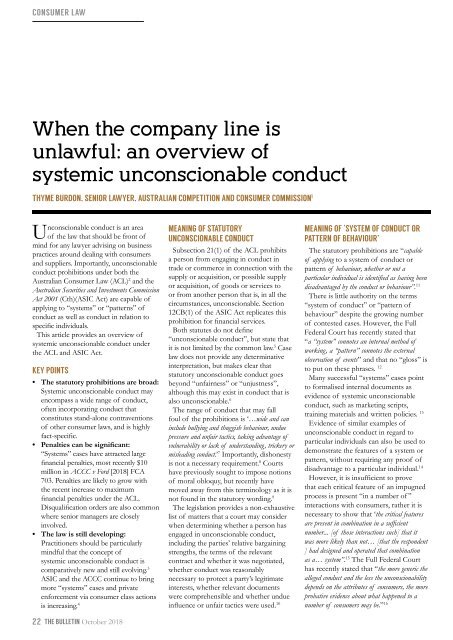LSB October 2018_Web
Create successful ePaper yourself
Turn your PDF publications into a flip-book with our unique Google optimized e-Paper software.
CONSUMER LAW<br />
When the company line is<br />
unlawful: an overview of<br />
systemic unconscionable conduct<br />
THYME BURDON, SENIOR LAWYER, AUSTRALIAN COMPETITION AND CONSUMER COMMISSION 1<br />
Unconscionable conduct is an area<br />
of the law that should be front of<br />
mind for any lawyer advising on business<br />
practices around dealing with consumers<br />
and suppliers. Importantly, unconscionable<br />
conduct prohibitions under both the<br />
Australian Consumer Law (ACL) 2 and the<br />
Australian Securities and Investments Commission<br />
Act 2001 (Cth)(ASIC Act) are capable of<br />
applying to “systems” or “patterns” of<br />
conduct as well as conduct in relation to<br />
specific individuals.<br />
This article provides an overview of<br />
systemic unconscionable conduct under<br />
the ACL and ASIC Act.<br />
KEY POINTS<br />
• The statutory prohibitions are broad:<br />
Systemic unconscionable conduct may<br />
encompass a wide range of conduct,<br />
often incorporating conduct that<br />
constitutes stand-alone contraventions<br />
of other consumer laws, and is highly<br />
fact-specific.<br />
• Penalties can be significant:<br />
“Systems” cases have attracted large<br />
financial penalties, most recently $10<br />
million in ACCC v Ford [<strong>2018</strong>] FCA<br />
703. Penalties are likely to grow with<br />
the recent increase to maximum<br />
financial penalties under the ACL.<br />
Disqualification orders are also common<br />
where senior managers are closely<br />
involved.<br />
• The law is still developing:<br />
Practitioners should be particularly<br />
mindful that the concept of<br />
systemic unconscionable conduct is<br />
comparatively new and still evolving. 3<br />
ASIC and the ACCC continue to bring<br />
more “systems” cases and private<br />
enforcement via consumer class actions<br />
is increasing. 4<br />
22 THE BULLETIN <strong>October</strong> <strong>2018</strong><br />
MEANING OF STATUTORY<br />
UNCONSCIONABLE CONDUCT<br />
Subsection 21(1) of the ACL prohibits<br />
a person from engaging in conduct in<br />
trade or commerce in connection with the<br />
supply or acquisition, or possible supply<br />
or acquisition, of goods or services to<br />
or from another person that is, in all the<br />
circumstances, unconscionable. Section<br />
12CB(1) of the ASIC Act replicates this<br />
prohibition for financial services.<br />
Both statutes do not define<br />
“unconscionable conduct”, but state that<br />
it is not limited by the common law. 5 Case<br />
law does not provide any determinative<br />
interpretation, but makes clear that<br />
statutory unconscionable conduct goes<br />
beyond “unfairness” or “unjustness”,<br />
although this may exist in conduct that is<br />
also unconscionable. 6<br />
The range of conduct that may fall<br />
foul of the prohibitions is ‘…wide and can<br />
include bullying and thuggish behaviour, undue<br />
pressure and unfair tactics, taking advantage of<br />
vulnerability or lack of understanding, trickery or<br />
misleading conduct.’ 7 Importantly, dishonesty<br />
is not a necessary requirement. 8 Courts<br />
have previously sought to impose notions<br />
of moral obloquy, but recently have<br />
moved away from this terminology as it is<br />
not found in the statutory wording. 9<br />
The legislation provides a non-exhaustive<br />
list of matters that a court may consider<br />
when determining whether a person has<br />
engaged in unconscionable conduct,<br />
including the parties’ relative bargaining<br />
strengths, the terms of the relevant<br />
contract and whether it was negotiated,<br />
whether conduct was reasonably<br />
necessary to protect a party’s legitimate<br />
interests, whether relevant documents<br />
were comprehensible and whether undue<br />
influence or unfair tactics were used. 10<br />
MEANING OF ‘SYSTEM OF CONDUCT OR<br />
PATTERN OF BEHAVIOUR’<br />
The statutory prohibitions are “capable<br />
of applying to a system of conduct or<br />
pattern of behaviour, whether or not a<br />
particular individual is identified as having been<br />
disadvantaged by the conduct or behaviour”. 11<br />
There is little authority on the terms<br />
“system of conduct” or “pattern of<br />
behaviour” despite the growing number<br />
of contested cases. However, the Full<br />
Federal Court has recently stated that<br />
“a “system” connotes an internal method of<br />
working, a “pattern” connotes the external<br />
observation of events” and that no “gloss” is<br />
to put on these phrases. 12<br />
Many successful “systems” cases point<br />
to formalised internal documents as<br />
evidence of systemic unconscionable<br />
conduct, such as marketing scripts,<br />
training materials and written policies. 13<br />
Evidence of similar examples of<br />
unconscionable conduct in regard to<br />
particular individuals can also be used to<br />
demonstrate the features of a system or<br />
pattern, without requiring any proof of<br />
disadvantage to a particular individual. 14<br />
However, it is insufficient to prove<br />
that each critical feature of an impugned<br />
process is present “in a number of ”<br />
interactions with consumers, rather it is<br />
necessary to show that ‘the critical features<br />
are present in combination in a sufficient<br />
number... [of those interactions such] that it<br />
was more likely than not… [that the respondent<br />
] had designed and operated that combination<br />
as a… system”. 15 The Full Federal Court<br />
has recently stated that “the more generic the<br />
alleged conduct and the less the unconscionability<br />
depends on the attributes of consumers, the more<br />
probative evidence about what happened to a<br />
number of consumers may be.” 16


















